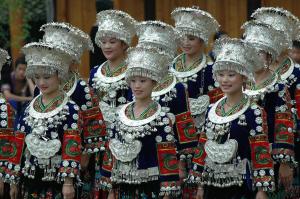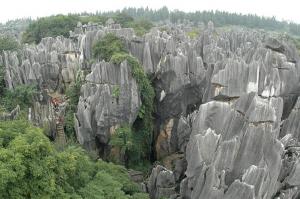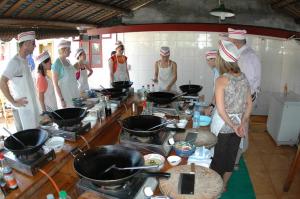Two sips of homemade rice wine from a sacred ox horn. A stroll through a forest of stone. A visit to a Chinese ethnic minority village. The jingling chorus of Maio women laden with silver jewelry, dancing. A lesson in Chinese cooking. The romantic night view of Hong Kong. All transportation and communication needs covered by a private car, driver and guide. Our trip through southwest China was all this and more with China Highlights.
My wife and I had been to Beijing and Shanghai. Though impressive, those metropolitan cities left us yearning to experience the deeper China. We contacted China Highlights Travel Agency because they offered customized tours. From our map and guidebooks, we selected a few interesting destinations along a course from Lijiang in Yunnan province to Hong Kong. We stressed that we wanted to experience the culture, visit some of the ethnic minority villages and see the real China. The itinerary that China Highlights created turned into one extraordinary vacation.
Our introduction to some of China’s ethnic minority groups began the morning after our arrival in Lijiang. Our guide, Ms. Li, a member of the Naxi ethnic minority, took us to a Naxi village. The Naxi people descend from Tibetan nomadic tribes. Today about 300,000 of them live in villages in Sichuan and Yunnan provinces.
The sight of the small village adorned with little more than the necessities of subsistence living was a bit of a surprise. The rough cobblestone main street was lined with old buildings made of wood and light-brown, handmade bricks. Untidy, slate gray tiled roofs had become overgrown with green moss. Doorways, shutters and building fronts, once painted dark red, were now faded and sagging. There were no cars except ours. A few old men with white beards sat motionless, smoking long bamboo pipes. Squatting in a doorway, two grandmothers were selling vegetables spread on the ground. Later we realized, that compared to other ethnic minority villages we visited, the conditions of this village were a little above the norm.
Ms. Li walked us through the village to the house of an elderly woman who welcomed foreign visitors. The kind woman happily answered our questions about the lifestyle of the Naxi people. She gave us peanuts and tea, then she dressed in the traditional Naxi clothing. As she modeled, turned and posed for our cameras, Li explained the function and style of each piece of clothing.
A few days later, near Dali, we visited a shop where we met four Bai women making colorful Batik patterns and designs. With the help of Lisa, our guide in Dali, the women explained the laborious 40-day process needed to produce one cloth. We also learned that Bai women reveal their marital statues and relative age by the hat they wear. One woman wore a round, cake-shaped, colorful red, black and white hat with a long white tassel. The long tassel identified her as a single woman. A married woman wore a similar hat, with a short tassel. Two grandmothers working there wore a comfortable looking, floral pattern, black velvet bonnet.
At a Miao Village, we were greeted at the gate by women dressed in traditional clothing singing a song to welcome us. To enter, we had to take two sips of rice wine from a sacred ox horn. The song climaxed with a long high “Yeeeeee” as we drank. Being a sacred horn, we were not allowed to touch it, so the wine was carefully poured into our mouths.
Miao women are known for their brightly embroidered skirts and blouses that are lavishly adorned with silver jewelry. The headdress, necklaces, bells and accessories attached to their traditional costumes can weigh as much as 15 pounds. At our second Miao Village, we were treated to a performance of Miao music and dance. The men played long bamboo flutes called Lusheng, while the women danced and jingled in full silver costumes. It was quite enchanting.

 Miao dance
Miao dance
To make things easy for customers, the guides at China Highlights adopt nicknames that are more familiar sounding to the customers they serve. All the guides spoke good English and were very knowledgeable. Michael, a guide who took us to several Dong and Miao villages, had actually lived with a Miao family for three months to learn their culture and traditions.
Another guide, Roger, took us through the maze of trails in the Shilin Karst Stone Forest near Kunming. While leading us on a less crowded path, he spiced up our walk with stories and names of the strange rock formations; eagle rock, bear paw, moon-gazing rhino, kissing rock and more. The Stone Forest was an eerie moonscape terrain engulfed by grey limestone rocks that looked like they had actually grown into deformed shapes. Some rocks towered above us, eclipsing the sun as we sidestepped between the cracks into the next stone arena. Others seemed so oddly shaped and unbalanced, they appeared as though they would topple over with the next gust of wind.

 Stone forest
Stone forest
By the time we reached Guilin, we had become acquainted with the Naxi, Bai, Dong and Miao ethnic minorities. From Guilin, our journey took on a different flavor, starting with a cruise down the famous Li River to Yangshuo. The Li River is so famous for its picturesque scenery that one view appears on the back of the 20 Yuan note. To prove its renowned status, at a precise spot along the river, our guide presented Rebecca with a 20-Yuan note for our confirmation. You could call the Li River cruise total immersion, stress-reduction therapy. Stand on the top open-air deck and you are surrounded by gently moving panoramic views of fantastic Karst Mountains that sharply rise hundreds of feet above the green forest. Heads of water buffalo emerge from the water to watch you. As the river curves and winds, each view absorbs you into the tranquility and harmony of the scene. It’s three hours of beautiful relaxation, served with a tasty lunch buffet.
In Yangshou we had an unexpected treat: a one-day Chinese cooking class. Class began at 9:00 a.m. in the farmers market. Our instructor, Liu Yan, the two of us and eight other students from Australia, Scotland and England bought the necessary ingredients. The menu: conpao (mixed chicken, peanuts and vegetables), beer fish and vegetable dumplings.

 Cooking class 1
Cooking class 1
Liu Yan was an experienced cooking teacher. She was also entertaining, especially when chopping vegetables for the dumplings. In seconds, with great speed, rhythm and a knife in each hand – kada-donk, kada-donk, kada-donk, kada-donk – she made the perfect mix for dumplings. Class ended at noon with the delicious lunch we had prepared.
We returned to Guilin, then flew to Hong Kong for our final four days. Hong Kong lived up to its reputation. The bird, flower, jade, antique, clothing and food markets were endless shopping temptations. The Star Ferry charges only HK$2.20 to cross the harbor. This is the most economical and scenic transportation in Hong Kong. Taking our picture next to the bronze statue of Bruce Lee on the Avenue of Stars was fun, but the real highlight was the romantic night view of the glittering skyscrapers and harbor from Victoria Peak. It really was a crowning moment of our wonderful trip.
China's history, culture and people have a multitude of layers. My wife and I agreed that we had seen a deeper China and more. Still, when traveling, there is always that insatiable yearning to go deeper and see more.